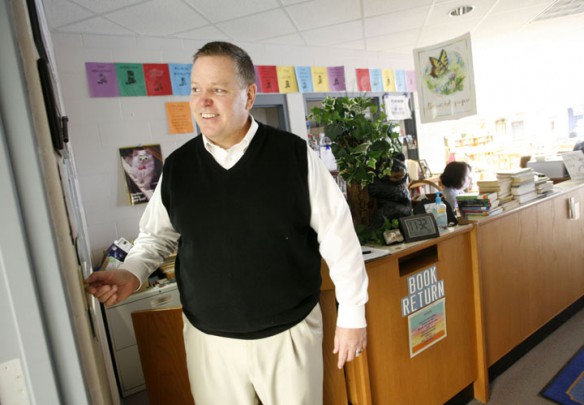
Butler County Middle School Principal Jeff Jennings switches off a light in the library. According to school energy manager Jimmy Arnold, teachers and administrators are taking it upon themselves to help with energy and utility costs. Photo by Amy Wallot, Jan. 6, 2012
By Matthew Tungate
matthew.tungate@education.ky.gov
Lights are a little dimmer – and savings a lot greater – at Northern Elementary School (Scott County) thanks to 4th-grade teacher Elizabeth Cook’s class.
Last year 4th graders measured the amount of light in the school’s gym, cafeteria, office and library. They found the common areas had more light than necessary, Cook said. So they took that information to School Energy Manager Jim McClanahan, who had spoken to the students about the importance of conservation.
“I told Jim what the students had discovered,” Cook said. “He looked at the students’ figures and agreed that the areas were overlit. This year, the maintenance crew removed florescent bulbs from the common areas so that energy was not being wasted on unnecessary lighting.”
Cook’s class serves as Northern Elementary’s energy team, and the school has been more than successful. Energy-reduction efforts at the school placed it No. 1 among Kentucky schools that participated in the 2011 Energy Star National Building Competition: Battle of the Buildings. The contest is sponsored by the Environmental Protection Agency. Northern Elementary was fifth nationally in K-12 schools and 13th among the 245 buildings in the competition.
Cook said the school saved $8,000 during the Battle of the Buildings contest year.
Cook and many other teachers across the state have counted on the Kentucky National Energy Education Development (NEED) and the School Energy Mangers Project (SEMP) to teach their students about energy and conservation.
NEED is a national non-profit education association whose primary goal is to provide resources and training for teachers to be able to teach energy in an efficient way, according to Karen Reagor, state director of the Kentucky NEED Project.
The organization provides workshops for teachers and online lessons plans lasting two-days to six weeks, she said, including what is energy, national resources that provide us with energy and how we make choices with energy use.
“Our philosophy is, ‘If we don’t understand what energy is and where it’s coming from and the advantages and disadvantages, we don’t really have the information to make wise energy decisions,’” Reagor said.
NEED also provides free or low-priced kits that teachers can use to teach about energy. Cook said the project her students did with the lights was in a NEED monitoring and mentoring kit.
NEED resources are directly tied to state and national standards for science, she said. Students study about the state’s resources in 4th-grade social studies, Cook said, and NEED also fits in perfectly with that.
“It’s not just another program,” she said. “It’s something that you can really, actually use that applies to what you’re supposed to be teaching in class anyway.”
Reagor, a former elementary school teacher, said the NEED curriculum is designed so that teachers never have to hear, “Why do we need to know this.”
“We can show the students, ‘This is why you need to know this. This is the impact that this information will have not only on your life, but on our lives as Kentuckians, as citizens of the U.S. and as global citizens, as well. So it’s really helping them to see that they do make a difference, they do have choices to make,” she said.
“It’s not about what they should do, but providing them with the background and the basics to understand how to make a wise choice. The choice is still theirs, but at least they’ll be based on factual content.”
Cook likes the way NEED presents information in an unbiased way, she said.
“You don’t have them telling you, ‘Oh, you’re not supposed to like coal,’ she said. “They’re telling you, ‘This is a resource Kentucky has, and here are other options, and we’re going to need to pick the best option.’”
Finding options for conserving is where the SEMP program comes in.
SEMP began in July 2010, according to Director Ron Willhite. When the project began, only 14 districts had an energy manager. Thanks to $5.05 million dollars of American Recovery and Reinvestment Act (ARRA) funding through the U.S. Department of Energy, 35 more energy managers are serving 130 school districts in the state, he said.
Willhite said SEMP is saving participating districts $4.5 million annually, plus $1.1 million in one-time savings.
“Their role is to provide a full-time resource dedicated to helping the district make intelligent choices about using energy,” he said.
Seventy-three of 174 Kentucky school districts have four or fewer buildings, Willhite said, while another 73 have between five and eight buildings. Most districts can’t justify having a full-time person to serve as an energy manager, which is why most SEMP employees serve two to seven districts, he said.
School Energy Manager Jon Nipple is a retired metallurgical engineer who serves Carroll, Gallatin, Owen, Grant counties and Williamstown Independent school districts.
Nipple points out that he’s not in classrooms very often. He works more with utility companies and vendors to see how he can bring down energy costs. He also looks at ways infrastructure can be changed to use less energy, such as efficient light bulbs and efficient building materials.
“My primary focus is really outside the classroom – although I know that without getting kids and teachers involved, a lot of what I do is futile,” he said.
That’s because changing behavior is the best way to save on energy costs, Nipple said.
“Schools are huge multipliers of things. We don’t have one light. We don’t have one computer. We have hundreds of lights and hundreds of computers. And when you have all of those things running at once, it’s not any one person that’s causing a problem. But in aggregate you could be causing a huge problem,” he said. “Now on the other hand, there’s leverage because of that multiplication also. If I save just a little bit on all of them, I’ve got huge leverage in a school or a school district.”
Nipple sees a grander goal than saving money just for the sake of saving money. His five small, rural districts spend $500,000-$1 million each per year on energy, he said.
If he can save 10 percent, “that saves at least a teacher and maybe two in every district.”
“My mantra, if I’ve got one, is, ‘It’s money for teachers, not for utilities,’” he said. “If I can pay less for utilities, I’ve got more money for salaries. There is a harsh reality to it.”
It is a harsh reality both Kentucky NEED and SEMP understand.
ARRA, also called federal stimulus, funding matched 75 percent of what school districts would pay for a school energy manager the first year, and matched 50 percent the second year, Willhite said. That funding ends June 30.
“Absent some follow-up funding, each district’s going to have to make a decision on the value that they see of having an energy manager,” he said.
“This program has built a lot of momentum. If it can be continued, there’s a lot more savings opportunities out there.”
Reagor said NEED has received state funding for 15 years – but it is coming to an end at the end of April.
ARRA funding allowed NEED to hire four regional coordinators, and four more are funded by LG&E/KU to serve K-8 schools who receive electricity from the company.
Those coordinators go into classrooms, conduct professional development for teachers and trainings for student energy teams where they learn to assess behaviors. Once the money is gone, only the four coordinators in the KU/LG&E service area will remain.
“This will be the first time in 15 years that I will have to ask a teacher when they call for help, ‘Where are you, what grade level and who’s your utility provider?’ And if they don’t say, “K-8, KU or LG&E,’ I’ll have to say, ‘Well, here’s what we have on the website and no, I can’t come to your classroom, no you can’t come to this workshop,’” Reagor said. “It’s going to be tough.”
MORE INFO…
Ron Willhite, ron.willhite@ksba.org, (502) 783-0058
Karen Reagor, kreagor@need.org, (866) 736-8941








Leave A Comment